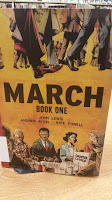 Sherman Alexie wrote a short essay entitled "Why the Best Kids Books Are Written in Blood" and it discusses important points teachers should consider when they're debating whether or not to read a book in class which discusses adult topics, such as sex or rape. Alexie delves into why it is sometimes necessary for Young Adult (YA) books, such as his own The Absolutely True Diary of a Part-Time Indian, to include dark, adult themes because they are preteens and teens reading these books who have dealt with similar experiences in their lives. As he says in the essay a teen mother wouldn't be traumatized by a novel about sex and someone who has been damaged by murder/rape won't be alarmed by a novel depicting the two. That's an important point to make because every person, especially adolescents, want to find characters that relate to them or media, i.e. books, movies, television shows, that relate to their lives. YA books such as Alexie's and Laurie Halse Anderson's Speak, along with countless others, exist because there are young adults out there who face/have faced the problems these novels depict. Even if your class is, or seems, privileged and innocent, there could still be a victim of sexual assault or someone who's had a pregnancy scare or someone who is the black sheep among their school and family. Regardless of your class, you should never eliminate a YA novel because you think the theme is too adult for your students. If it has the distinction YA, it was meant to be read by teenagers and sometimes even younger crowds. I read Speak when I was in middle school. Books can often times be more than just words written on paper and, as an English teacher, you probably already know that. Books are used as an escape, but as Alexie said they can also be used as weapons, helping people to arm themselves against their demons as well as the demons of society. As Doctor Who once said "You want weapons? We're in a library! Books! The best weapons in the world!" Sometimes the books that get through to teenagers the most are the ones that are dangerous and help them stand up to the dangers in their own lives because unfortunately children aren't always as protected as they should be and they need novels that will help them, rather than protect them. Having your students read this essay and then bringing in a book, or something similar, a c.d., a movie, that they believe is written in their blood and explain why will help you better understand your students and maybe their lives as well.
Sherman Alexie wrote a short essay entitled "Why the Best Kids Books Are Written in Blood" and it discusses important points teachers should consider when they're debating whether or not to read a book in class which discusses adult topics, such as sex or rape. Alexie delves into why it is sometimes necessary for Young Adult (YA) books, such as his own The Absolutely True Diary of a Part-Time Indian, to include dark, adult themes because they are preteens and teens reading these books who have dealt with similar experiences in their lives. As he says in the essay a teen mother wouldn't be traumatized by a novel about sex and someone who has been damaged by murder/rape won't be alarmed by a novel depicting the two. That's an important point to make because every person, especially adolescents, want to find characters that relate to them or media, i.e. books, movies, television shows, that relate to their lives. YA books such as Alexie's and Laurie Halse Anderson's Speak, along with countless others, exist because there are young adults out there who face/have faced the problems these novels depict. Even if your class is, or seems, privileged and innocent, there could still be a victim of sexual assault or someone who's had a pregnancy scare or someone who is the black sheep among their school and family. Regardless of your class, you should never eliminate a YA novel because you think the theme is too adult for your students. If it has the distinction YA, it was meant to be read by teenagers and sometimes even younger crowds. I read Speak when I was in middle school. Books can often times be more than just words written on paper and, as an English teacher, you probably already know that. Books are used as an escape, but as Alexie said they can also be used as weapons, helping people to arm themselves against their demons as well as the demons of society. As Doctor Who once said "You want weapons? We're in a library! Books! The best weapons in the world!" Sometimes the books that get through to teenagers the most are the ones that are dangerous and help them stand up to the dangers in their own lives because unfortunately children aren't always as protected as they should be and they need novels that will help them, rather than protect them. Having your students read this essay and then bringing in a book, or something similar, a c.d., a movie, that they believe is written in their blood and explain why will help you better understand your students and maybe their lives as well."I write in blood because I remember what it felt like to bleed."-Sherman Alexie














